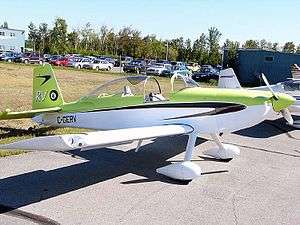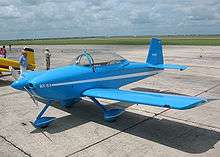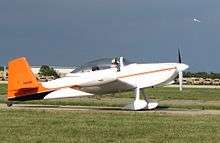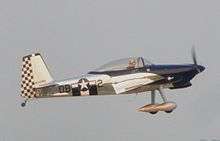Van's Aircraft RV-8
The Van's RV-8 is a tandem two-seat, single-engine, low-wing homebuilt aircraft sold in kit form by Van's Aircraft. The RV-8 is equipped with conventional landing gear, while the RV-8A version features tricycle landing gear. The design is similar to the earlier RV-4, although it is larger than that earlier model.[3][4][5]
| RV-8 | |
|---|---|
 | |
| Role | RV-8 |
| National origin | United States |
| Manufacturer | Van's Aircraft |
| Designer | Richard VanGrunsven |
| First flight | 1995[1] |
| Introduction | 1995[1] |
| Number built | 1536 (October 2019)[2] |
| Unit cost |
USD$41,000–98,000 |
| Developed from | Van's Aircraft RV-4 |



Development
Richard VanGrunsven designed the RV-8 series as an updated, larger tandem aircraft based on the RV-4 design concept. The RV-8 first flew in 1995 and was first shown publicly at Oshkosh that year.[1]
The RV-8 incorporated changes as a result of lessons learned in producing the popular RV-4 design. The RV-8 airframe accepts larger engines from 150 to 200 hp (112 to 149 kW), including the 200 hp (149 kW) Lycoming IO-360. The RV-8 also has increased wingspan and wing area over the RV-4, as well as greater cockpit width, headroom, legroom and an increased useful load, all with a view to accommodating larger pilots. Like the RV-3 to RV-7 that preceded it, the RV-8 is stressed for aerobatics.[1][5]
The RV-8 series was intended from inception to include a nose-gear-equipped version designated the RV-8A. The RV-8A was first flown in 1998[1]
As of October 2019, 1,536 RV-8s and RV-8As have been completed and flown.[2]
Specifications (RV-8)
Data from Van's Aircraft[6][7]
General characteristics
- Crew: one
- Capacity: one passenger
- Length: 21 ft 0 in (6.40 m)
- Wingspan: 24 ft 0 in (7.32 m)
- Height: 5 ft 7 in (1.70 m)
- Wing area: 116 sq ft (10.8 m2)
- Empty weight: 1,120 lb (508 kg)
- Gross weight: 1,800 lb (816 kg)
- Fuel capacity: 42 U.S. gallons (160 L; 35 imp gal)
- Powerplant: 1 × Lycoming IO-360 four cylinder, horizontally opposed piston aircraft engine with fuel injection, 200 hp (150 kW)
Performance
- Maximum speed: 221 mph (356 km/h, 192 kn)
- Cruise speed: 210 mph (340 km/h, 180 kn) at 75% power at 8000 feet
- Stall speed: 58 mph (93 km/h, 50 kn)
- Range: 940 mi (1,510 km, 820 nmi) at 55% power and 8000 feet
- Service ceiling: 22,500 ft (6,900 m)
- Rate of climb: 1,900 ft/min (9.7 m/s)
- Wing loading: 15.5 lb/sq ft (76 kg/m2)
See also
Related development
Aircraft of comparable role, configuration and era
References
- "Total Performance RV Kit Planes". Van's Aircraft. Retrieved 2012-08-21.
- Vans Aircraft (October 2019). "First Flights". Retrieved 18 October 2019.
- Downey, Julia (December 2007), "Kitplanes", 2008 Kit Aircraft Directory, 24, Primedia, p. 77, ISSN 0891-1851.
- Vandermeullen, Richard: 2011 Kit Aircraft Buyer's Guide, Kitplanes, Vol. 28, No. 12, December 2011, p. 74. Belvoir Publications. ISSN 0891-1851
- Bayerl, Robby; Martin Berkemeier; et al: World Directory of Leisure Aviation 2011–12, p. 125. WDLA UK, Lancaster UK, 2011. ISSN 1368-485X
- "Van's Aircraft - RV-8 Specifications". Vansaircraft.com. Retrieved 2012-08-21.
- "Van's Aircraft - RV-8 Performance". Vansaircraft.com. Retrieved 2012-08-21.
External links
| Wikimedia Commons has media related to Van's Aircraft RV-8. |